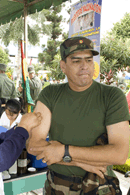
The components of human security, as illustrated in Chapters I and II, are not new concerns for PAHO. The threat of international epidemics was among the chief reasons PAHO was originally founded in 1902 as the International Sanitary Bureau. The impact of conflict on health was addressed by PAHO’s efforts to use “health as a bridge for peace” in Central America during the 1980s, while disaster response and risk reduction, like safe water and sanitation, are longstanding areas of work for the Organization. Even PAHO’s work in areas such as community and intra-family violence, healthy environments, and traffic safety began in the 1990s, before human security became a central theme on the international agenda.
As a “new” concept, however, human security can be seen to add value to PAHO’s technical cooperation in public health in several ways. It highlights the fundamental importance of health to human well-being and, by viewing health as inherent to human security, it gives governments major responsibility for ensuring and protecting it. It also elucidates the connections between health and other aspects of human security, thereby confirming the need for intersectoral action and providing guidance for its design. In these ways, the human security approach complements and strengthens PAHO’s growing focus on the social determinants of health.
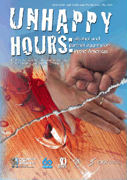 It is also true that public health has made significant contributions to the field of human security, particularly by providing ethical and methodological guidance for addressing its complex social dimensions. The use of an epidemiological approach to the issue of violence, for example, has led to evidence-based public health interventions to address it. The successful use of such interventions-for example, in Bogotá and Medellín, Colombia-has helped changed the perception that violence is an inevitable social ill. By contrast, the persistence and increase of violence in other countries is at least partly the result of a failure to apply a public health approach, particularly by identifying and addressing the underlying social determinants of violence.
It is also true that public health has made significant contributions to the field of human security, particularly by providing ethical and methodological guidance for addressing its complex social dimensions. The use of an epidemiological approach to the issue of violence, for example, has led to evidence-based public health interventions to address it. The successful use of such interventions-for example, in Bogotá and Medellín, Colombia-has helped changed the perception that violence is an inevitable social ill. By contrast, the persistence and increase of violence in other countries is at least partly the result of a failure to apply a public health approach, particularly by identifying and addressing the underlying social determinants of violence.
Chapter II of this report presented highlights of efforts by PAHO member countries to apply public health approaches to the various components of human security in 2009–10. These efforts produced important advances and yielded valuable lessons, yet many challenges remain to be met. Some of the most noteworthy of these are presented and discussed below.
Economic Security
The economies of Latin America and the Caribbean have been affected to different degrees and in different ways by the global economic downturn. Health spending has been constrained in most countries, and unemployment has reduced contributions to social security regimes while also reducing the capacity of poor households to absorb out-of-pocket healthcare costs. At the same time, deteriorating economic conditions have negatively impacted the social determinants of health. In all these ways, the crisis is likely to further widen the already existing gaps between countries’ economic progress and their levels of human development. PAHO studies suggest that the most important factors perpetuating these gaps are inequitable income distribution, the lack of harmonization of social policies, and weaknesses and inefficiencies in the organization of national health systems.
PAHO member countries face the challenge, both short- and medium-term, of developing new financing solutions for the health sector and new mechanisms of access to social protection that are not exclusively employment-based. Equally important are continued efforts to increase the efficiency, effectiveness, and equity of health systems through reforms grounded in the principles of primary health care.
Food Security

Latin America and the Caribbean as a region remain on track to meet the hunger-reduction targets of MDG-1. But rising food prices, the global economic downturn, and ecological crises have slowed progress and have increased important disparities within and across countries. Moreover, chronic malnutrition-which is not included in the MDG targets-remains high in a number of countries and among the most vulnerable population groups. Regionwide, an estimated 9 million children under 5 suffer from chronic malnutrition, while some 22.3 million preschool children, 3.6 million pregnant women, and 33 million women of childbearing age suffer from anemia-all this in a region that produces 130 percent of its basic food needs.
PAHO’s experience suggests that nutrition is not a simple function of economic status but that it plays a complex and, as a critical factor in human development, partly causal role in the interaction between economics and health. Chronic malnutrition in particular is the result of multiple factors, including direct ones such as maternal malnutrition, poor diet, and repeated infections as well as indirect ones, including lack of access to safe water and sanitation, inadequate quantity and quality of foods, frequent exposure to unsafe foods, low educational levels of mothers, teen pregnancy, poor health care, and poor child-raising practices. Indeed, chronic malnutrition, measured as low height for age, is a meaningful indicator of the overall life conditions in a given population.
The complex interactions between nutrition and other social and economic determinants call for integrated multisectoral approaches that seek to improve people’s physical and social environments; ensure access to safe water, sanitation, and hygiene; improve education and information (including information about safe food handling); increase food security; ensure decent work, working conditions, and income; and increase access to quality health services that employ proven nutrition interventions throughout the life course and that promote reproductive health, particularly during pregnancy and pre-pregnancy.
Secure Environments
Environmental influences are among the most important determinants of human health and security and have wide-ranging and interrelated impacts. Major forces that shape the environment in Latin America and the Caribbean include population growth and distribution, climate change, patterns of economic development, and income inequality. The Region is also highly susceptible to natural disasters such as earthquakes, storms, drought, and floods.
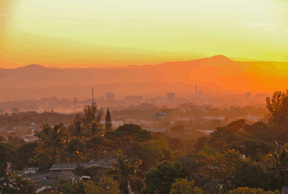
As the world’s most urbanized region, the Americas face major challenges stemming from rapid and unplanned urban growth. Informal settlements, substandard housing, and inadequate water and sanitation services increase the vulnerability of marginal urban populations-particularly the poor, Afro-descendants, and indigenous people-to diseases and environmental hazards. Inadequate transportation systems and growing traffic congestion increase air pollution and put pedestrians, cyclists, and motorists at risk of injuries or death. Urban centers characterized by high population density and neglected zones become areas of exclusion and poverty that breed violence, crime, and substance abuse. Moreover, a shortage of public parks and green spaces combines with other patterns of urbanization and development to encourage lifestyles that increase people’s risk factors for chronic noncommunicable diseases.
Rural populations too are affected by some of these same problems, particularly substandard housing and lack of access to safe water and sanitation. Regionwide, an estimated 40 million people, both rural and urban, lack access to improved drinking water, and 115 million lack access to improved sanitation facilities, increasing their exposure to water- and foodborne diseases and disease-carrying rodents and insects. The vast majority of the estimated 190 million people living in poverty in the Region reside in inadequate housing and/or precarious geological zones, increasing their vulnerability to natural disasters.
Addressing these environmental influences on human security requires integrated multisectoral and multidisciplinary approaches that mobilize political commitment as well as social participation and action. These include primary environmental care projects and programs as well as “healthy governance” approaches that advocate for equitable allocation of resources by demanding accountability, transparency, and proper public policy management from local governments. In these approaches, it is important to identify community assets-including human, financial, and physical resources as well as social networks, civic organizations, and local leaders-and build upon these to develop infrastructure, programs, and processes that maximize those resources and that are fully aligned with communities’ characteristics and needs.
Also needed are urban and development planning and policies that emphasize managed growth, safe and smoke-free public spaces, risk reduction for natural and manmade hazards, and transportation systems that include mass transit as well as bikeways, walkways, and other incentives for physical activity.
All these approaches require, for any given environmental context, assessing the health and equity challenges and opportunities, identifying stakeholders-both individuals and institutions-and developing their capacity to take action, ensuring intersectoral collaboration, mobilizing or redistributing resources, implementing programs, and advocating for policy change.
Disasters and Response
Haiti’s catastrophic January 12 earthquake was a tragic reminder that chronic poverty, haphazard urbanization, and weak governance enhance vulnerabilities to natural disasters. At the same time, the international response to the disaster underscored the pivotal role of coordination in emergency relief operations.
With an estimated 220,000 dead and 300,000 injured, UN and other international agencies, nongovernmental organizations, and bilateral teams mobilized a massive influx of human and material resources to help victims of the disaster. The destruction of transportation and health infrastructure-including the loss of Haiti’s Ministry of Health building along with many of its key personnel-created unprecedented challenges in managing these resources. PAHO’s PROMESS warehouse, which was fully stocked when the earthquake struck, played an important role in distributing medicines and medical supplies to where they were most needed.
PAHO also provided critical leadership as head of the Health Cluster, coordinating the efforts of health partners as they established field hospitals, mobile health clinics, water and sanitation facilities, and a referral network linked to functioning hospitals. Among the major challenges in this regard were keeping track of changes in partners’ locations, operations, and scope of services and maintaining consistency between the work of these partners and the objectives and priorities of Haiti’s Ministry of Health.
The six-month report of the Inter-Agency Standing Committee (IASC) on the Haiti response points out that, in general, the international humanitarian community failed to engage sufficiently with local organizations and authorities, and therefore missed the opportunity to benefit from their expertise and local knowledge. An exception to this rule was organizations with permanent in-country operations. PAHO, which had a permanent staff of 52 in Port-au-Prince, was able to respond better and provide better leadership as a result of its longstanding relations with government officials, local partners, and the Haitian people.
Chile’s February 27 earthquake was some 500 times stronger than Haiti’s, yet the impact of the quake and ensuring tsunami was far less devastating. In Chile, the affected areas were less densely populated, housing and infrastructure were more structurally sound, and the government, headquartered far from the epicenter, was left intact and was fully able to respond.
Despite the loss of 4,000 hospital beds, Chile’s health system was able to provide needed services throughout the emergency. This was made possible by the rapid deployment of field hospitals and the fact that the majority of permanent hospitals in the affected areas remained functioning.
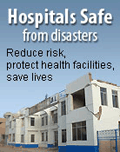
Most hospitals that did suffer damage were older structures that had not been upgraded to reduce their vulnerabilities to disasters. Many of these damaged facilities were near, and in some cases just meters away from, new hospitals or health facilities that suffered little or no damage. These newer facilities, built to “safe hospital” standards, continued providing health services, absorbing the demand left by the damaged structures. Chile now has the opportunity to build or retrofit all its hospitals to be disaster-safe.
Other lessons from Chile’s quake include the need to improve early warning systems, update preparedness and response plans, and provide simulation exercises and training to improve collaboration and coordination among the institutions involved in disaster response.
Personal Security
Violence and personal insecurity remain serious problems in many countries of the Region and, in many cases, are on the increase. PAHO’s support has been aimed at promoting public health interventions where these can make a difference, particularly in the areas of gender-based and intra-family violence, adolescent health and development, and homophobia and stigma.
While progress has been made in the areas of gender-based and intra-family violence, much more work remains to be done. Primary prevention, that is, preventing violence before it takes place, is a relatively new field that is still building a knowledge base about risk and protective factors and effective interventions. Current evidence suggests that exposure to violence in childhood is a consistent risk factor for both perpetrators and victims of violence later in adult life. However, strategies to address child maltreatment and gender-based violence are often implemented separately. Greater efforts are needed to address these and other issues, such as poverty and alcohol use, in an integrated manner and to intervene at a young age. Moreover, primary prevention efforts are necessarily multisectoral and need to bring together various actors, including from the health, education, social, and judicial sectors. PAHO is working to strengthen the capacity of Member States to carry out primary prevention strategies in various ways, including through capacity-building workshops and rigorous evaluation of innovative efforts, such as home visitation programs for adolescent mothers.

Although primary prevention of violence is a priority, it is also important to ensure that survivors of violence have access to appropriate health services and to justice. Additional efforts are needed to strengthen the quality of existing services, increase monitoring and evaluation of these efforts, and determine the best strategies to address new challenges, such as gender-based violence as it relates to migration, HIV/AIDS, the drug trade, and natural disasters. PAHO is working to improve the health sector response to survivors of gender-based violence through efforts to build capacity on monitoring and evaluation of gender-based violence programs and the publication of resource manuals.
Finally, while considerable progress has been made toward improving the quality of prevalence data on gender-based violence in the Region, limited comparability and a lack of follow-up studies make it difficult to contrast data across countries and to monitor trends over time. PAHO is working with other organizations, such as the CDC, to improve the quality, availability, and use of population-based data on gender-based violence to help strengthen programming in this area.
As for stigma and discrimination, there have been many positive developments at the global and regional levels. Nevertheless, discrimination against people with different sexual orientations or sexual identities persists in society in general and in the health sector in particular. It directly contributes to the spread of HIV, as the fear of stigma tends to dissuade people from seeking HIV testing and counseling as well as treatment. Studies have documented the effects on victims of homophobic bullying, which can include lack of sleep, loss of appetite, isolation, nervousness, elevated rates of actual and attempted suicide, absenteeism and truancy, and limited achievement at school.
Other manifestations of homophobia and transphobia range from job and social discrimination to verbal and physical violence, including murder, prompting several PAHO member countries to begin registering hate crimes against sexual minorities.
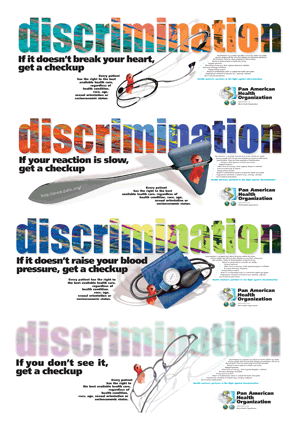
Changing the values and attitudes that underlie homophobia and transphobia requires the participation of health providers, families, communities, policymakers, and other key stakeholders. Civil society and national authorities must come together to define and standardize clear values regarding diversity, safety, inclusion, and human rights and the unacceptability of stigma and discrimination. Support should be given to individuals who suffer discrimination or aggression, and institutions and individuals need to be held accountable for their actions in this regard. Nevertheless, preventive, rather than reactive, action should be the priority. In addition, countries should step up their monitoring of homophobic and transphobic discrimination and violence.
A related challenge is discrimination associated with social exclusion, an important social determinant of health and human security. This type of discrimination can increase during times of economic stress, when competitive strategies for personal and family survival can eclipse concerns such as social solidarity and the common welfare. Examples include growing anti-immigrant sentiment and questioning of the affordability of social protection schemes (see also below). In these contexts, public health proponents must continue to stress the interdependence of individuals, communities, and countries and the fact that individual security depends heavily on collective security.
Systems for Social Protection
The notion that people have a human right to social security is gaining currency at the global and regional levels, producing considerable political will for expanding social protection systems. This is reflected in the new Social Protection Floor Initiative, led by the ILO and WHO and supported by 19 UN agencies as well as development banks, bilateral organizations and NGOs. In the Region of the Americas, this growing political will can be seen in the September 2009 launch of the new Inter-American Social Protection Network, in response to a request by heads of state at the Fifth Summit of the Americas four months earlier. The network is intended to facilitate the exchange of experiences to support the development of social protection systems that are efficient and effective in reducing poverty and inequality and improving quality of life for the Region’s poor.

The experiences of Bolivia and Haiti show that schemes for social protection in health are not luxuries that only higher-income countries can afford. On the contrary, in poorer countries they can contribute to notable improvements in population health, particularly by reducing maternal and infant mortality. Moreover, history shows that societies with wide social protection are the most resilient in times of economic stress. Marshaling such evidence can strengthen advocacy for establishing and expanding social protection in health even in the current economic climate.
For existing social protection systems, the most important short-term challenge is sustainability. This is especially true in countries such as Haiti that lack a tax structure to generate the necessary funds for these systems to continue functioning. But even better-established social protection systems face this challenge during times of economic strain. Finding new ways of financing these systems sustainably and without relying solely on employment contributions is essential. In poorer countries like Haiti, it will be necessary to align all available resources-including both domestic and international cooperation funds-with national health plans under the direction of the country’s health authorities.
The H1N1 Pandemic
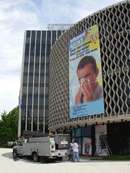
As noted in Chapter II, the 2009–10 H1N1 influenza pandemic tested several years’ worth of pandemic preparedness efforts undertaken by the hemisphere’s countries with PAHO support. In a meeting in mid-September 2009, representatives from PAHO Member States discussed those efforts in the context of the H1N1 pandemic. Among their conclusions were the following:
Despite the moderate-to-mild virulence of the H1N1 virus, the 2009–10 pandemic exposed weaknesses in countries’ health systems. In several countries, the large numbers of cases put such a strain on health services that regular surgeries and other services had to be postponed. Certain risk groups, particularly pregnant women, were more heavily impacted than is recognized by the general public, and partly as a consequence, pregnant women were among the groups with the lowest uptake of the pandemic H1N1 vaccine.
The pandemic also highlighted once again the importance of public trust in health authorities and evidence-based decision-making, as well as the power of fear based on poor information. The adoption of unnecessary restrictions on people’s movements or gatherings and the public’s limited uptake of the new H1N1 vaccine in many parts of the world are just two examples.
One of the most important lessons of the 2009–10 pandemic speaks in a larger sense to the issue of human security: in a globalized world, no individual, family, community, or country can be completely secure when the security of others is at serious risk. This means that investments in public health, strengthening of health systems, international partnerships, and solidarity are the best weapons to defend against the next, quite possibly more virulent, global public health enemy, whether a new influenza virus or a different threat. Combined with intersectoral efforts that address the other components of human security, such investments and partnerships will yield short- and longer-term dividends for both human and societal development, strengthening the resilience of countries while substantially improving their populations’ quality of life.
This report covers a very challenging year for public health in the Region of the Americas. Most of the preparedness efforts paid off. Nevertheless, the huge differences in countries’ capacities to ensure the human security of their citizens remain a priority to be addressed. Solidarity and horizontal cooperation among countries on health matters have again been shown to be strong assets in the quest to protect peoples’ lives and well-being. At the same time, PAHO's mission of leading strategic collaborative efforts has again proved vital to imnproving the well-being, health, and security of the peoples of the Americas.